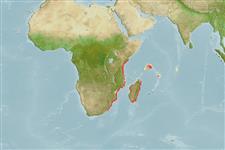>
Acropomatiformes (Oceanic basses) >
Pempheridae (Sweepers)
Etymology: Pempheris: Greek, pempheris = the name of a fish (Ref. 45335); eatoni: Named for Patrick Eaton who collected the holotype and five other adult specimens for this study.
Eponymy: Patrick Eaton, about whom we have failed to find more information than is contained in the original text. [...] (Ref. 128868), visit book page.
Environment: milieu / climate zone / depth range / distribution range
экология
морской ассоциированный с рифами; пределы глубины 1 - 15 m (Ref. 97766). Tropical
распространение
страны | регионы FAO | Ecosystems | места находок | Point map | интродукции | Faunafri
Western Indian Ocean: South Africa and Mozambique.
Size / Вес / Возраст
Maturity: Lm ? range ? - ? cm
Max length : 14.0 cm SL самец/пол неопределен; (Ref. 97766)
Краткое описание
определительные ключи | морфология | морфометрия
колючие лучи спинного плавника (общее число) : 6; членистые (мягкие) лучи спинного плавника (общее число) : 9 - 10; колючие лучи анального плавника: 3; членистые (мягкие) лучи анального плавника: 38 - 44; позвонки: 25. This species is distinguished by the following characters: D VI,9-10 (usually 9); A III,38-44; pectoral rays 17-19; lateral-line scales 53-60; chest entirely with ctenoid scales; caudal fin scaled on about basal fourth; gill rakers 28-33; body depth 2.2-2.35 in SL; head length 3.3-3.4 in SL; orbit diameter 7.15-7.7 in SL; longest dorsal ray 3.7-4.05 in SL; pectoral-fin length 3.3-3.55 in SL; colour in alcohol gray-brown, scale edges narrowly gray, the dorsal fin brownish gray with an apical black spot, the color of anal fin like body basally, with a broad blackish middle zone, the margin narrowly whitish, the caudal fin is yellowish gray, paired fins are pale yellowish, the pectorals with a dark brown band across base, the iris is grayish blue (Ref. 97766).
Occurs in exposed rocky shores and often in small groups that shelter in caves or beneath ledges by day from depths as little as 1-2 m to at least 15 m. It has been observed to venture out of shelter at night to feed on planktonic invertebrates and larval fishes. It was also reported to have an extensive spawning season, judging from seeing shoals of juveniles through
most of the year. The gonads of adults were noted to be nearly always mature regardless of the time of year. It was also observed to swim slowly, when not stressed, propelling itself mainly by characteristic ‘sweeps’ of the pectoral fins (hence the common name sweeper). Smallest fully mature female specimen, 11.6 cm SL (Ref. 97766).
Life cycle and mating behavior
половая зрелость | размножение | нерест | икра | Fecundity | личинки
Randall, J.E. and B.C. Victor, 2014. Four new fishes of the genus Pempheris (Perciformes: Pempheridae) from the western Indian Ocean. J. Ocean Sci. Found. 12:61-83. (Ref. 97766)
Статус Красного Списка МСОП (Ref. 130435: Version 2024-1)
Угроза для людей
Harmless
Использование человеком
дополнительная информация
инструменты
Специальные отчеты
Скачать в формате XML
ресурсы в Интернет
Estimates based on models
Phylogenetic diversity index (Ref.
82804): PD
50 = 0.5000 [Uniqueness, from 0.5 = low to 2.0 = high].
Bayesian length-weight: a=0.01380 (0.00591 - 0.03225), b=3.02 (2.83 - 3.21), in cm total length, based on LWR estimates for this Genus-body shape (Ref.
93245).
Trophic level (Ref.
69278): 3.5 ±0.5 se; based on size and trophs of closest relatives
устойчивость к внешним воздействиям (Ref.
120179): высокий, минимальное время удвоения популяции до 15 месяцев (Preliminary K or Fecundity.).
Fishing Vulnerability (Ref.
59153): Low vulnerability (10 of 100).
